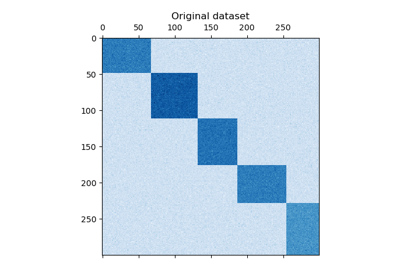make_biclusters#
- sklearn.datasets.make_biclusters(shape, n_clusters, *, noise=0.0, minval=10, maxval=100, shuffle=True, random_state=None)[source]#
Generate a constant block diagonal structure array for biclustering.
Read more in the User Guide.
- Parameters:
- shapetuple of shape (n_rows, n_cols)
The shape of the result.
- n_clustersint
The number of biclusters.
- noisefloat, default=0.0
The standard deviation of the gaussian noise.
- minvalfloat, default=10
Minimum value of a bicluster.
- maxvalfloat, default=100
Maximum value of a bicluster.
- shufflebool, default=True
Shuffle the samples.
- random_stateint, RandomState instance or None, default=None
Determines random number generation for dataset creation. Pass an int for reproducible output across multiple function calls. See Glossary.
- Returns:
- Xndarray of shape
shape The generated array.
- rowsndarray of shape (n_clusters, X.shape[0])
The indicators for cluster membership of each row.
- colsndarray of shape (n_clusters, X.shape[1])
The indicators for cluster membership of each column.
- Xndarray of shape
See also
make_checkerboardGenerate an array with block checkerboard structure for biclustering.
References
[1]Dhillon, I. S. (2001, August). Co-clustering documents and words using bipartite spectral graph partitioning. In Proceedings of the seventh ACM SIGKDD international conference on Knowledge discovery and data mining (pp. 269-274). ACM.
Examples
>>> from sklearn.datasets import make_biclusters >>> data, rows, cols = make_biclusters( ... shape=(10, 20), n_clusters=2, random_state=42 ... ) >>> data.shape (10, 20) >>> rows.shape (2, 10) >>> cols.shape (2, 20)
